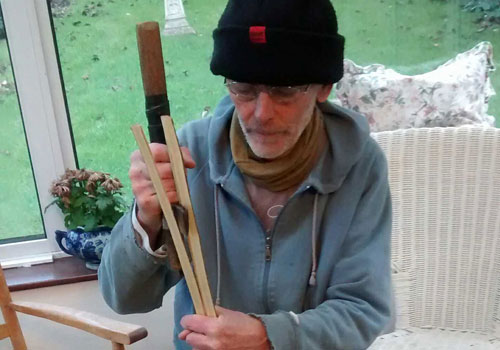

Long straw preparation involves shaking the straw, dampening it, drawing/pulling it and gathering into yealms (slab or tile amounts of straw) and then six of these yealms are tied into a bundle.
This process is very laborious and time consuming and quite often not seen by the client. An average cottage roof requires three days preparation of straw by three men.

The existing thatch has to be assessed to decide what old thatch requires removal. The criteria is leaving enough to form a sound base coat, not disturbing historical layers and removing enough to keep the dimensions appropriate to the building. Quite often the base coat requires fixing to the roof; normally it is metal spiked with wooden rods holding down the material to the rafters, in particular on the verges.
The straw yealms are then pegged to the base coat. The eave and gables have an overhang, which requires trimming. Eaves are cut square to the building; gables are cut with a slight leaning out overhang to give a clean drip away from the building. The verges invariably have a border rod.
Our normal coat thickness is 12”-14” (300mm-350mm) thick. The ridge can be block cut, ornamental or the plain flush type. The latter is seeing a revival in its popularity amongst conservation officers. The whole roof is wire netted. We use 19g netting (most thatchers use thinner 20g and some even weak 22g). The netting is tucked neatly into the join between the thatch and roof, not nailed or stapled to soffits or fascias, which makes painting impossible and looks unsightly.
Abutments are normally carried out with mortar but lead is preferred in some cases. Every thatcher has their own finish to long straw and there is a lot of argument within the trade as to what is wrong and what is right. Usually the people who have the most to say have carried little or no long straw work. We have carried out hundreds of long straw thatches and have examples that have lasted thirty years.
Normally carried out on a total refurbishment where new rafters and timber work are required, or a new build, or a reinstatement of thatch on, say, a roof which previously had corrugated iron cladding. The roof is re-battened as required with treated batten and fixed with galvanised nails. We recommend the under wiring of barns to keep rats out of the finished thatch. The straw is prepared in exactly the same way as before. It is fixed to the roof with galvanised steel hooks and either wood or galvanised steel rods. The straw requires a lot of back filling to maintain maximum pitch over rafters.
Our normal thickness over the rafters is 16”-18” (400mm-450mm). Ridging and netting are the same as the top coat system. Exposing rafters for strengthening may require listed consent and the owner will most likely be asked for an independent survey on the thatch and roof structure. Our policy always remains do not remove anything, but add by the side to strengthen.
We can supply green oak, ash pole rafters and elm pole rafters if required. These give a like for like finish often preferred by conservation officers. (See photograph of roof completely re-roofed with elm pole rafters).